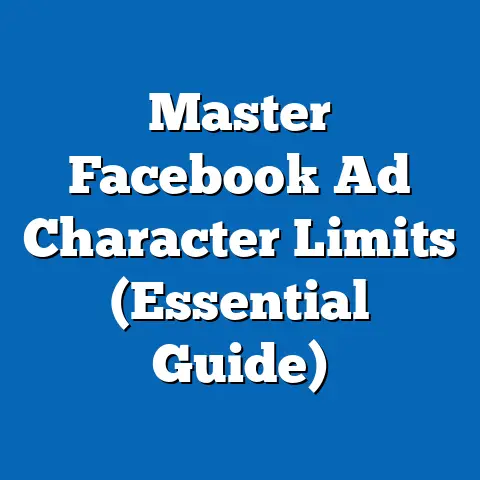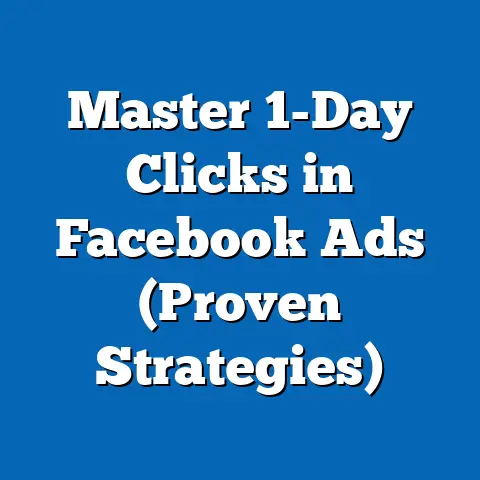Streamline Facebook Ads Payment Setup (Expert Guide)
I’ve seen firsthand how powerful Facebook Ads can be, especially for small businesses and entrepreneurs just starting out. The ability to reach a massive, targeted audience is a game-changer, but the cost can be daunting. What many overlook is how crucial the payment setup is to actually maximizing the affordability of those ads. It’s not just about slapping in a credit card and hoping for the best. It’s about strategically choosing the right payment method, understanding budgeting, and optimizing spend based on performance. Think of it as laying the foundation for a successful and cost-effective advertising campaign. In this guide, I’ll walk you through the ins and outs of setting up your Facebook Ads payments to not only ensure your ads run smoothly but also to squeeze every last drop of value out of your advertising budget.
Section 1: Understanding Facebook Ads Payment Options
Facebook offers a variety of payment methods, each with its own set of pros and cons when it comes to cost-effectiveness and ease of setup. Let’s break them down:
Credit/Debit Cards
This is often the most straightforward and commonly used option. Most major credit and debit cards are accepted, including Visa, Mastercard, American Express, and Discover.
- Benefits:
- Ease of Use: Quick and simple to set up. Most people already have a credit or debit card.
- Widely Accepted: Facebook accepts a broad range of card types.
- Potential Rewards: You might earn points, cashback, or other rewards on your advertising spend.
- Drawbacks:
- Transaction Fees: Depending on your card and location, you might incur foreign transaction fees or other charges.
- Credit Limits: Your advertising spend is limited by your available credit.
- Security Concerns: Some people are hesitant to use credit cards online due to security risks.
- Ease of Use: Quick and simple to set up. Most people already have a credit or debit card.
- Widely Accepted: Facebook accepts a broad range of card types.
- Potential Rewards: You might earn points, cashback, or other rewards on your advertising spend.
- Transaction Fees: Depending on your card and location, you might incur foreign transaction fees or other charges.
- Credit Limits: Your advertising spend is limited by your available credit.
- Security Concerns: Some people are hesitant to use credit cards online due to security risks.
My Experience: I’ve personally used credit cards for years to fund my Facebook Ads. The convenience is undeniable. However, I always make sure to monitor my card statements closely for any unusual activity and keep my credit utilization low to avoid impacting my credit score.
PayPal
PayPal provides a secure and convenient way to pay for your Facebook Ads using your PayPal balance, bank account, or credit/debit card linked to your PayPal account.
- Benefits:
- Security: PayPal acts as a buffer, protecting your credit card information from being directly exposed to Facebook.
- Convenience: Easy to link your bank account or credit/debit card to PayPal.
- International Payments: Simplifies international transactions, often with lower fees than direct credit card payments.
- Drawbacks:
- PayPal Fees: PayPal charges transaction fees, which can add up over time.
- Account Limitations: PayPal accounts can be subject to limitations or holds, potentially disrupting your advertising campaigns.
- Currency Conversion Fees: If you’re advertising in a different currency than your PayPal account, you’ll be subject to currency conversion fees.
- Security: PayPal acts as a buffer, protecting your credit card information from being directly exposed to Facebook.
- Convenience: Easy to link your bank account or credit/debit card to PayPal.
- International Payments: Simplifies international transactions, often with lower fees than direct credit card payments.
- PayPal Fees: PayPal charges transaction fees, which can add up over time.
- Account Limitations: PayPal accounts can be subject to limitations or holds, potentially disrupting your advertising campaigns.
- Currency Conversion Fees: If you’re advertising in a different currency than your PayPal account, you’ll be subject to currency conversion fees.
Real-World Example: I worked with a client who was advertising in multiple countries. Switching from direct credit card payments to PayPal significantly reduced their foreign transaction fees, saving them a substantial amount each month.
Direct Bank Transfers (Availability Varies by Region)
In some regions, Facebook allows you to pay for your ads directly from your bank account.
- Benefits:
- No Credit Limit Constraints: Not limited by your credit card limit.
- Potentially Lower Fees: Can avoid credit card transaction fees.
- Drawbacks:
- Availability: Not available in all countries.
- Setup Complexity: Setting up direct bank transfers can be more complex than using a credit card or PayPal.
- Processing Time: Payments might take longer to process compared to other methods.
- No Credit Limit Constraints: Not limited by your credit card limit.
- Potentially Lower Fees: Can avoid credit card transaction fees.
- Availability: Not available in all countries.
- Setup Complexity: Setting up direct bank transfers can be more complex than using a credit card or PayPal.
- Processing Time: Payments might take longer to process compared to other methods.
Statistical Insight: According to a recent study by Statista, credit cards are the most popular payment method for online advertising, followed by PayPal. However, direct bank transfers are gaining traction in certain regions due to their potential cost savings.
Key Takeaway: The best payment method for you will depend on your individual circumstances, including your location, banking relationships, and risk tolerance. Consider the transaction fees, currency conversion rates, and ease of setup when making your decision.
Next Steps: Research the specific fees and terms associated with each payment method in your region.
Section 2: Setting Up Your Facebook Ads Account
Setting up your Facebook Ads account correctly from the start is crucial for a smooth and affordable advertising experience. Here’s a step-by-step guide:
Step 1: Choose the Right Account Type
Facebook offers two main types of advertising accounts:
- Personal Ad Account: Linked to your personal Facebook profile. Suitable for small-scale advertising or testing.
- Business Manager Account: Designed for businesses and agencies managing multiple ad accounts and users.
Why This Matters: Using a Business Manager account offers several advantages:
- Centralized Management: Manage multiple ad accounts, pages, and users from a single dashboard.
- Granular Permissions: Assign different roles and permissions to team members, controlling access to your advertising assets.
- Business-Level Reporting: Access comprehensive reporting and analytics across all your ad accounts.
- Compliance and Security: Ensures compliance with Facebook’s advertising policies and provides enhanced security features.
My Recommendation: If you’re serious about advertising on Facebook, I highly recommend setting up a Business Manager account. It provides the scalability and control you need to manage your campaigns effectively.
Step 2: Navigate to the Facebook Ads Manager
The Ads Manager is your central hub for creating and managing your Facebook Ads. You can access it in a few ways:
- From Your Facebook Profile: Click the dropdown arrow in the top right corner of your Facebook page and select “Manage Ads.”
- Directly Via URL: Go to
facebook.com/adsmanager. - From Your Business Manager: In your Business Manager, click the “Business Tools” button and select “Ads Manager.”
Step 3: Add a Payment Method
Once you’re in the Ads Manager, follow these steps to add a payment method:
- Click the “Billing” Tab: This is usually located in the left-hand navigation menu. If you don’t see it, click “All Tools” and then find “Billing.”
- Click “Payment Settings”: This will take you to the payment settings page.
- Click “Add Payment Method”: A pop-up window will appear, prompting you to choose your payment method.
- Select Your Payment Method: Choose from credit/debit card, PayPal, or direct bank transfer (if available).
- Enter Your Payment Information: Follow the on-screen instructions to enter your payment details. Ensure you provide accurate information to avoid any issues.
- Save Your Payment Method: Once you’ve entered all the required information, click “Save.”
Important Note: Facebook might require you to verify your payment method. This usually involves confirming a small charge on your card statement or linking your bank account.
Step 4: Set a Spending Limit (Optional but Recommended)
To prevent unexpected charges, I highly recommend setting a spending limit on your ad account. This will ensure that your advertising spend doesn’t exceed your budget.
- Go to “Payment Settings”: As described in Step 3.
- Click “Set Account Spending Limit”: This option might be located under “Spending Limit” or a similar section.
- Enter Your Desired Spending Limit: Set a limit that aligns with your budget.
- Save Your Changes: Click “Update Limit” or “Save” to apply the spending limit.
My Pro Tip: Start with a lower spending limit and gradually increase it as you become more comfortable with Facebook Ads and your campaign performance improves.
Key Takeaway: Setting up your Facebook Ads account correctly, choosing the right account type, and adding a secure payment method are essential steps for a smooth and affordable advertising experience. Don’t forget to set a spending limit to control your budget.
Next Steps: Create your Facebook Business Manager account and add your preferred payment method.
Section 3: Budgeting for Facebook Ads
Budgeting for Facebook Ads can feel like navigating a minefield, especially if you’re new to the platform. But with a clear understanding of the different budgeting options and how to analyze key metrics, you can make informed decisions about your spending.
Daily vs. Lifetime Budgets
Facebook offers two main budgeting options:
- Daily Budget: The average amount you’re willing to spend each day on your ad set. Facebook will try to spend this amount each day, but it might fluctuate slightly.
- Lifetime Budget: The total amount you’re willing to spend over the entire duration of your ad set. Facebook will distribute your budget evenly over the chosen period.
Which One Should You Choose?
- Daily Budget: Ideal for campaigns that run continuously or for testing different ad creatives and targeting options. It allows you to monitor performance and make adjustments on a daily basis.
- Lifetime Budget: Best for campaigns with a specific end date, such as promoting a limited-time offer or event. It ensures that your budget is spread evenly over the entire duration of the campaign.
My Experience: I typically use daily budgets for ongoing campaigns and lifetime budgets for campaigns with a defined start and end date. This allows me to maintain control over my spending and optimize performance in real-time.
Understanding CPC and CPM
Two key metrics to analyze when budgeting for Facebook Ads are:
- Cost-Per-Click (CPC): The amount you pay each time someone clicks on your ad.
- Cost-Per-Impression (CPM): The amount you pay for every 1,000 impressions (times your ad is shown).
How to Interpret These Metrics:
- High CPC: Indicates that your ad might not be relevant to your target audience or that your ad creative isn’t compelling enough.
- Low CPC: Suggests that your ad is resonating well with your target audience and that your ad creative is effective.
- High CPM: Can indicate that you’re targeting a highly competitive audience or that your ad quality is low.
- Low CPM: Suggests that you’re targeting a less competitive audience or that your ad quality is high.
Real-World Example: I once ran a campaign with a high CPC. After analyzing the data, I realized that my targeting was too broad. By narrowing my target audience and creating more relevant ad creatives, I was able to significantly reduce my CPC and improve my campaign performance.
Setting Realistic Budgets
Setting a realistic budget is crucial for achieving your advertising goals without breaking the bank. Here are a few tips:
- Start Small: If you’re new to Facebook Ads, start with a small budget and gradually increase it as you gain more experience.
- Consider Your Business Goals: Align your budget with your specific goals. Are you trying to generate leads, drive website traffic, or increase brand awareness?
- Analyze Industry Benchmarks: Research industry benchmarks for CPC and CPM to get a sense of what to expect.
- Test Different Budgets: Experiment with different budgets to see what works best for your business.
- Monitor Performance: Regularly monitor your campaign performance and adjust your budget accordingly.
Statistical Insight: According to a report by WordStream, the average CPC for Facebook Ads across all industries is around \$1.86. However, this can vary significantly depending on your industry, target audience, and ad quality.
My Pro Tip: Don’t be afraid to experiment with different budgeting options and targeting strategies. The key is to continuously monitor your performance and make adjustments based on the data.
Key Takeaway: Budgeting for Facebook Ads requires a strategic approach. Understand the different budgeting options, analyze key metrics like CPC and CPM, and set realistic budgets based on your business goals and industry benchmarks.
Next Steps: Research industry benchmarks for CPC and CPM in your niche and create a sample budget for your first Facebook Ads campaign.
Section 4: Optimizing Payment Methods for Cost-Effectiveness
Choosing the right payment method isn’t just about convenience; it can significantly impact your overall advertising budget. Here’s how to optimize your payment methods for maximum cost-effectiveness:
Choosing the Most Cost-Effective Payment Method
- Transaction Fees: Compare the transaction fees associated with each payment method. Credit card fees can vary widely, and PayPal charges its own set of fees.
- Currency Conversion Rates: If you’re advertising in a different currency than your payment method, pay close attention to the currency conversion rates. Some payment methods offer better rates than others.
- Promotional Offers: Keep an eye out for promotional offers from Facebook or your payment provider. Some credit cards offer cashback or rewards on advertising spend.
Real-World Example: I had a client who was using a credit card with high foreign transaction fees. By switching to a credit card with no foreign transaction fees, they saved hundreds of dollars each month.
Taking Advantage of Facebook Ad Credits and Discounts
Facebook occasionally offers ad credits and discounts to new advertisers or for specific campaigns. Be sure to take advantage of these opportunities to reduce your advertising costs.
- New Advertiser Credits: Facebook often provides ad credits to new advertisers to encourage them to try the platform.
- Promotional Campaigns: Facebook sometimes runs promotional campaigns offering discounts on specific ad types or for certain events.
- Partner Programs: Some Facebook partners offer discounts or incentives to their clients.
My Experience: I’ve received several ad credits from Facebook over the years. These credits have allowed me to experiment with new ad formats and targeting strategies without risking my own budget.
Monitoring Ad Spend and Adjusting Payment Methods
Regularly monitor your ad spend and adjust your payment methods as needed to maximize affordability.
- Track Your Spending: Use the Facebook Ads Manager to track your spending on a daily, weekly, and monthly basis.
- Analyze Performance: Analyze your campaign performance to identify areas where you can reduce costs.
- Adjust Bids and Budgets: Adjust your bids and budgets based on your performance data.
- Switch Payment Methods: If you’re consistently incurring high transaction fees or currency conversion rates, consider switching to a more cost-effective payment method.
Statistical Insight: A study by AdEspresso found that businesses that regularly monitor their ad spend and adjust their campaigns accordingly can reduce their advertising costs by up to 30%.
My Pro Tip: Set up automated rules in the Facebook Ads Manager to automatically pause or adjust your campaigns based on your spending and performance data. This can help you stay within your budget and avoid overspending.
Key Takeaway: Optimizing your payment methods for cost-effectiveness requires a proactive approach. Choose the most cost-effective payment method, take advantage of ad credits and discounts, and regularly monitor your ad spend and adjust your payment methods as needed.
Next Steps: Review your current payment methods and identify potential areas for cost savings.
Section 5: Troubleshooting Common Payment Setup Issues
Even with careful planning, you might encounter issues when setting up your payment methods for Facebook Ads. Here’s how to troubleshoot some common problems:
Declined Payments
A declined payment can be frustrating, but it’s often easy to resolve. Here are some common causes and solutions:
- Insufficient Funds: Make sure you have sufficient funds in your account.
- Incorrect Information: Double-check that you’ve entered your payment information correctly, including your card number, expiration date, and CVV code.
- Expired Card: Ensure that your card hasn’t expired.
- Bank Restrictions: Contact your bank to make sure they’re not blocking the transaction.
- Facebook Restrictions: Facebook might have placed a restriction on your account due to suspicious activity. Contact Facebook support to resolve this issue.
Real-World Example: I once had a client whose payments were being declined because their bank was flagging the transactions as suspicious. After contacting the bank and authorizing the transactions, the issue was resolved.
Expired Cards
Expired cards are a common cause of payment issues. To avoid this problem, make sure to update your payment information before your card expires.
- Update Your Payment Information: Go to the “Payment Settings” in the Facebook Ads Manager and update your card information.
- Set a Reminder: Set a reminder in your calendar to update your card information before it expires.
Account Verification Problems
Facebook might require you to verify your account to ensure that you’re a legitimate advertiser. This usually involves confirming your identity and providing proof of address.
- Follow Facebook’s Instructions: Follow the instructions provided by Facebook to verify your account.
- Provide Accurate Information: Provide accurate and up-to-date information to avoid any delays in the verification process.
- Contact Facebook Support: If you’re having trouble verifying your account, contact Facebook support for assistance.
My Pro Tip: Be proactive and verify your account as soon as possible to avoid any disruptions in your advertising campaigns.
Preventing Disruptions in Ad Campaigns
To prevent disruptions in your ad campaigns, it’s essential to maintain up-to-date payment information and monitor your account regularly.
- Set Up Payment Notifications: Enable payment notifications in the Facebook Ads Manager to receive alerts when your payment method is about to expire or when a payment is declined.
- Monitor Your Account Regularly: Regularly monitor your account for any signs of suspicious activity or payment issues.
- Have a Backup Payment Method: Add a backup payment method to your account to ensure that your ads continue running even if your primary payment method fails.
Key Takeaway: Troubleshooting common payment setup issues requires a proactive and systematic approach. Identify the problem, follow the appropriate troubleshooting steps, and maintain up-to-date payment information to prevent disruptions in your ad campaigns.
Next Steps: Review your current payment settings and ensure that all your information is accurate and up-to-date.
Section 6: Leveraging Facebook Ads Insights for Better Payment Management
Facebook Ads Insights is a powerful tool that can help you analyze your spending patterns and ad performance, allowing you to make data-driven decisions about your payment setups.
Analyzing Spending Patterns and Ad Performance
- Track Your Spending Over Time: Use the Facebook Ads Manager to track your spending over time. This will help you identify any trends or patterns in your spending.
- Analyze Key Metrics: Analyze key metrics like CPC, CPM, and conversion rate to understand how your ads are performing.
- Identify High-Performing Campaigns: Identify your high-performing campaigns and allocate more budget to them.
- Identify Underperforming Campaigns: Identify your underperforming campaigns and either optimize them or pause them.
Real-World Example: I worked with a client who was spending a significant amount of money on a campaign that wasn’t generating any leads. By analyzing the data in Facebook Ads Insights, I discovered that the campaign was targeting the wrong audience. After narrowing the target audience, the campaign’s performance improved dramatically.
Adjusting Payment Setups Based on Performance Data
Based on your performance data, you can adjust your payment setups to ensure cost-effectiveness.
- Adjust Bids and Budgets: Adjust your bids and budgets based on your performance data. If a campaign is performing well, increase your budget. If a campaign is underperforming, decrease your budget or pause the campaign.
- Optimize Targeting: Optimize your targeting based on your performance data. If a particular audience is responding well to your ads, target that audience more aggressively.
- Experiment with Ad Creatives: Experiment with different ad creatives to see what resonates best with your target audience.
- Test Different Payment Methods: Test different payment methods to see which one offers the best combination of cost-effectiveness and convenience.
My Pro Tip: Use A/B testing to compare different ad creatives, targeting options, and payment methods. This will help you identify the most effective strategies for your business.
Examples of Successful Payment Setup Optimization
Here are a few examples of businesses that successfully optimized their payment setups based on insights and saw improved ROI:
- E-commerce Business: An e-commerce business analyzed their Facebook Ads Insights and discovered that their mobile ads were performing significantly better than their desktop ads. They adjusted their budget allocation to focus more on mobile ads, resulting in a 20% increase in sales.
- Lead Generation Company: A lead generation company analyzed their Facebook Ads Insights and discovered that their CPC was higher than industry benchmarks. They experimented with different ad creatives and targeting options, eventually reducing their CPC by 15%.
- Local Restaurant: A local restaurant analyzed their Facebook Ads Insights and discovered that their ads were performing best during lunch and dinner hours. They adjusted their ad schedule to focus on these peak hours, resulting in a 10% increase in foot traffic.
Statistical Insight: According to a study by HubSpot, businesses that use data-driven insights to optimize their marketing campaigns are 5-6 times more likely to achieve their revenue goals.
Key Takeaway: Leveraging Facebook Ads Insights is essential for better payment management. Analyze your spending patterns and ad performance, adjust your payment setups based on performance data, and learn from successful examples of payment setup optimization.
Next Steps: Dive into your Facebook Ads Insights and start analyzing your spending patterns and ad performance.
Conclusion
Navigating the world of Facebook Ads can feel overwhelming, but mastering the art of payment setup is a critical step towards achieving affordable and effective advertising. From understanding the various payment options to optimizing your budget and troubleshooting common issues, each aspect plays a crucial role in maximizing your ROI. By implementing the strategies and tips I’ve shared in this guide, you’ll be well-equipped to streamline your payment processes, enhance your advertising efforts, and ultimately drive business growth. Remember, effective advertising is not just about spending money; it’s about spending it wisely. And a strategic payment setup is the foundation for that wise spending.
Call to Action
I’d love to hear about your experiences with Facebook Ads payment setups! Share your tips, challenges, and successes in the comments section below. And if you found this guide helpful, subscribe for more expert insights and tips on digital marketing strategies. Let’s unlock the power of effective advertising together!






